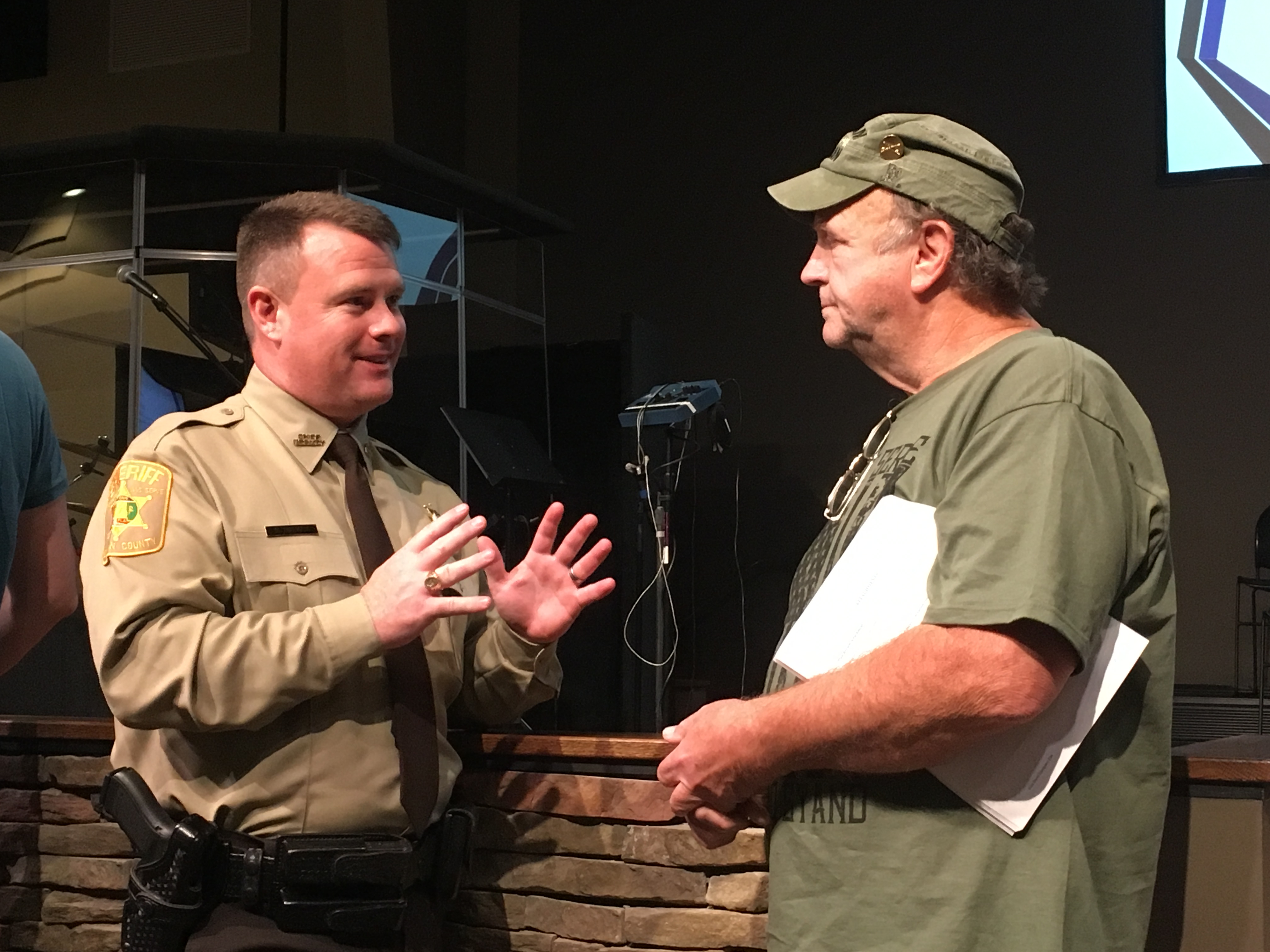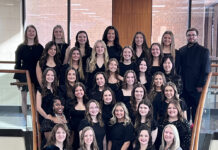Chief Deputy Brett Holmes, left, speaks to an attendee after Tuesday night's Cullman County Sheriff's Office church safety class at Temple Baptist Church. / W.C. Mann
CULLMAN – In light of the recent Texas church shooting and other violent tragedies, Sheriff Matt Gentry decided that Cullman County’s churches should be ready to deal with emergencies. Local churches seem to think so, too. On Tuesday evening, the Cullman County Sheriff’s Office (CCSO) planned for 600 participants to attend its church safety class at Temple Baptist, but empty seats were in the minority in the church’s large auditorium as more than 1,000 citizens from both Cullman and surrounding counties came to learn how to make their congregations safer. Investigator Trevor Clemmons and School Resource Officer, Deputy Chad Whaley led the class on establishing security teams and procedures in local church settings.
“Ideally, you’d like to have someone who is in charge of security that takes it very seriously and he’s the guy that needs to be bugging people about security measures. You also need the tools for the church’s safety,” Clemmons said. “We need to have surveillance cameras set up if possible; cameras are important. I know finances can be a problem and that everybody can’t afford thousands of dollars for cameras, but any type of camera you can set up would be great.”
“With church,” said Whaley, “it’s different from a school setting, it’s different from a business setting, because churches are designed to bring people in. We want people to come to know Christ, we want people to get closer to God. So we’ve got to be very careful in how we set up these safety teams and how we do these things, because we don’t want to push people away. We’ve got to keep that in mind whenever we look at these things.”
The instructors and instructional materials distributed to early arrivers recommended the development of a church safety plan including (from the handout):
–A site survey to find out how secure church property can be that includes lighting, door locks, door barricades, fire/smoke alarm systems, availability of safety exits, video security cameras, public address systems or alarm buzzers/bells, and auto-text messaging to smart phones to post alerts for emergency instructions.
–A medical alert team that is made up of members with medical training (medical doctors, RNs, EMTs, or others who can respond to medical emergencies.
–A security response team. These members must be trained and have the physical ability to safely remove a person who is disorderly, possibly mentally disturbed, or aggressive that has come to disrupt services or attack a member.
–A system of layered security made up of greeters, ushers or monitors that meets and subtly screens worshipers for persons who might pose a threat to others. The monitors would also protect parking lots, entrances and exits, and would watch over the facility while worship services or events are taking place.
Clemmons’ presentation touched on the use of weapons, noting that many implements may be used for defense. He focused on firearms, expressing confidence that his Cullman County audience had no shortage of such tools. Clemmons laid out “four cardinal rules of firearms safety” for handling firearms and using them defensively:
- Treat all guns as if they are loaded.
- Keep the muzzle pointed in a safe direction.
- Keep your finger outside the trigger guard until you are on target and have decided to fire.
- Be sure of your target, what’s around it, and what is beyond it.
According to Clemmons, “If you are engaging in a lot of firearms-type stuff, or you’re tasked with teaching other people, or showing your children, or whatever the case is, if you have them memorize those four cardinal safety rules, they’ll probably come back to be very helpful to you in the long run.”
Clemmons also stressed situational awareness.
“You should always be looking for indicators of unusual emotion, unusual behavior as well as unusual clothing,” he said. “Anyone standing near or sitting in a vehicle, someone walking to the door frantically looking around, running to the door, two people entering the building and then heading in different directions. These are all indicators that can be caught early.”
A.L.I.C.E.
Whaley told the crowd bluntly, “We, as law enforcement, have failed you over the years, because we have taught you over and over again: wait on us. Hide and wait on the police, we’re coming to help you, because we are. But the problem is, if you hide and wait, you’re not going to have time to survive.
“The two things that the killers are looking for, that they must have in order to be successful as bad guys- they’ve got to have time to pull that trigger, and they’ve got to have something to point it at. If you aren’t there, he can’t kill you. If he has time to pull the trigger, he’s going to be successful.
Whaley’s presentation centered on the A.L.I.C.E. program used for school security all over the country, including Cullman County’s schools, saying that it “takes one or both of those elements (mentioned in the previous paragraph) away from the bad guy.”
The program, designed as a response to active shooter emergencies, emphasizes five points:
A – ALERT – An alert, alarm, public address, text or call must be made to let members know an emergency is happening. 911 should be called as soon as possible for immediate response, and the church should have medical supplies available to give first aid until help arrives.
L – LOCKDOWN – All persons should immediately secure and lock entrances, classrooms, nurseries, offices and hallways to prevent intruders from gaining access.
I – INFORM – Notify everyone that a threat exists, and give a specific location if possible.
C – COUNTER – Try to stop the threat, disrupt and distract the attacker’s attention and thought processes (throwing things, making noise, etc.), attack the attacker, disarm them, disable them or physically restrain them till help arrives.
E – EVACUATE – Get everyone out of the endangered area safely. Make plans for the elderly, disabled, small children or babies in nurseries so that they may be escorted. Make sure people know about a predetermined reunification area where family members can meet them after an evacuation, whether it is in another building or alternate location.
Both Clemmons and Whaley called for situational awareness, for people to be aware of their surroundings, to know how many ways there are into and out of their building and auditorium/sanctuary, to decide how many entrances are needed and how many could safely be closed off at certain times. Clemmons pointed out the particular problem of how few people are actually facing a church’s main entrances during worship services. Whaley called for church members to pay attention to what kinds of vehicles are in their parking lots, and how they secure their nurseries.
In his closing remarks, Whaley cited Teddy Roosevelt: “In the moment of decision, the best thing you can do is the right thing. The second-best thing you can do is the wrong thing. The worst thing you can do is nothing.”
Whaley concluded, “If you take nothing else away from what I have told you tonight, if your option is to hide and hope, or do something; please do something. Please do something.”
After the meeting, the Tribune asked Whaley if he had any final advice for church leaders. His answer was simple and to the point: “Be proactive, and be prepared.”
Gentry said that his office can visit local congregations to help create individualized safety and security plans. If your church is interested in having the CCSO assist you in developing a plan, contact Capt. Mark Persall at mpersall@cullmansheriff.org, or call 256-734-0342.
Copyright 2017 Humble Roots, LLC. All Rights Reserved.



















